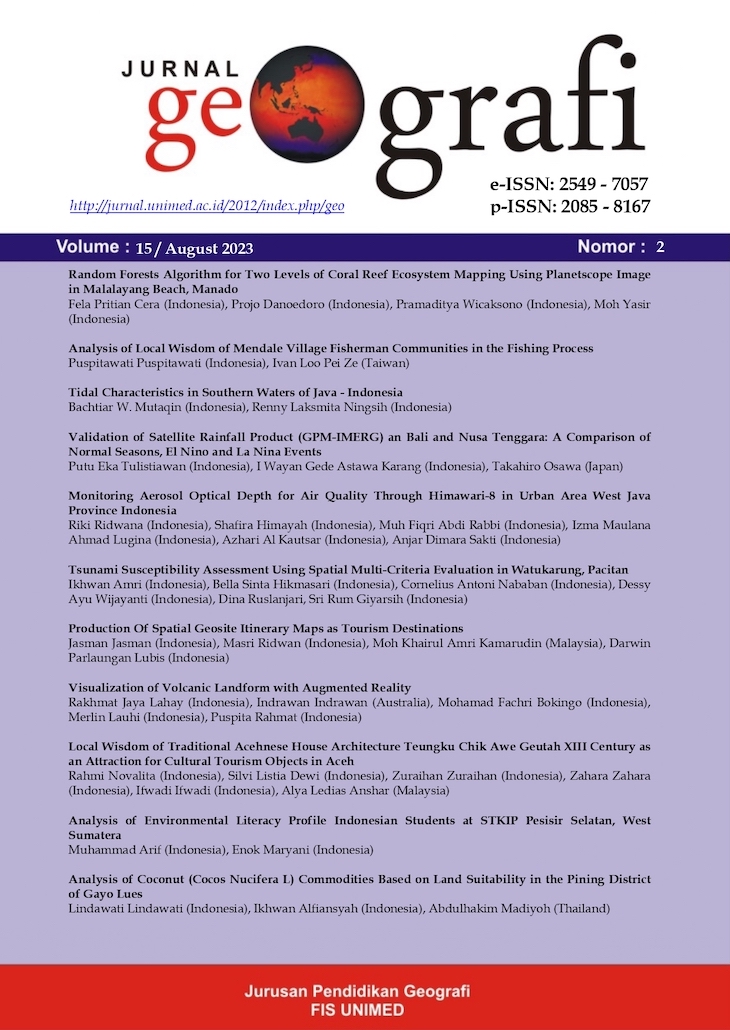Random Forests Algorithm for Two Levels of Coral Reef Ecosystem Mapping Using Planetscope Image in Malalayang Beach, Manado
DOI:
https://doi.org/10.24114/jg.v15i2.30795Abstract
The coral reef ecosystem has a significant physical and biological function and is also one of the coastal ecosystem components apart from the seagrass and mangrove ecosystem. Besides their ecological function, the coral reef also has an economic function. The condition of the coral reef ecosystem in Malalayang Beach has been changing for years. The utilization of remote sensing images can monitor current conditions. This research aims to map the coral reef ecosystem mapping in Malalayang Beach, Manado and conduct a test for the accuracy of coral reef ecosystem mapping using field survey data as a classification and validation sample. PlanetScope multispectral image has four channels to detect underwater objects: red, green, blue and near infrared. PlanetScope level 3B image for the research has a surface reflectance value for its pixel. The image processing stages of this research consist of sunglint correction, water column correction, and then continue to classify the coral reef ecosystem using random forests algorithm. Classification and accuracy training sample data were obtained using the photo transect technique. The sunglint correction regression equation is between 0.27 “ 0.38. The coefficient of attenuation ratio in B1 is 0.927797938, B2 is 0.168841585, and B3 is 0.29033029. This value then becomes the input for the Lyzenga formula. The classification accuracy for level one using random forests is 72,54%, and the accuracy for level two mapping is 37,61%.Keywords: Coral Reef Ecosystem, Planetscope, Random ForestsReferences
Adji, A. S., Indrabudi, T., dan Alik, R. Penerapan Metode Foto Transek Bawah Air untuk Mengetahui Tutupan Terumbu Karang di Pulau Pombo, Maluku. Jurnal Ilmu dan Teknologi Kelautan Tropis. 8(2):633-643
Arie, N. Wahyuni, F. S. 2016. Penggunaan Metode Machine Learning Untuk Pengenalan Pola Tutupan Lahan Pada Citra Satelit. Seminar Nasional Teknologi Informasi dan Multimedia 2016
Biau, G. Analysis of a Random Forests Model. Journal of Machine Learning Research. 13: 1063 “ 1095
Collison, A., and N. Wilson. 2017. Planet Surface Reflectance Product. San Francisco, CA: Planet Labs.
Danoedoro, P. 2012. Pengantar Penginderaan Jauh Digital. Yogyakarta: CV. Andi Offset
Dean, A. Dan Kleine, D. 2012. Coral Reefs and Climate Change. The University of Queensland: Queensland
Dewi, N. K., Syafitri, U. D., Mulyadi, S. Y. 2011. Penerapan Metode Random Forest dalam Driver Analysis. Forum Statistika dan Komputasi. 16(1):35-43
Giyanto, Abrar, M., Hadi, T. A., Budiyanto, A., Hafizt, M., Salatalohy, A., & Iswari, M. Y. (2017). Status Terumbu Karang Indonesia 2017 Giyanto Muhammad Abrar Tri Aryono Hadi Agus Budiyanto Muhammad Hafizt Abdullah Salatalohy Marindah Yulia Iswari COREMAP-CTI Pusat Penelitian Oseanografi “ LIPI (Issue June).
Hafizt, M. dan Danoedoro, P. 2015. Kajian Pengaruh Koreksi Kolom Air pada Citra Multispektral Worldview-2 untuk Pemetaan Habitat Bentik di Pulau Kemujan Kepulauan Karimunjawa Kabupaten Jepara. Prosiding Pertemuan Ilmiah Tahunan XX 2015. 566-575
Jaelani, L., Laili, N., Marini, Y. (2015). Pengaruh Algoritma Lyzenga Dalam Pemetaan Terumbu Karang Menggunakan WorldView-2. Jurnal Penginderaan Jauh Vol. 12 No. 2.
Kay, S., Hedley, J. D., & Lavender, S. (2009). Sun glint correction of high and low spatial resolution images of aquatic scenes: A review of methods for visible and near-infrared wavelengths. Remote Sensing, 1(4), 697“730. https://doi.org/10.3390/rs1040697
Khorram, S. Koch, F H. Wiele, C F. Nelson, S A C. 2012. Remote Sensing. Springer
Koch, M and Mather, M., 2011. Computer Processing of Remotely-Sensed Images an Introduction. Forth Edition. Wiley Blackwell.
Kushardono, D. 2017. Klasifikasi Digital Pada Penginderaan Jauh. Bogor: IPB Press
Miththapala, S. 2008. Coral Reefs. Coral Ecosystem Series (Vol 1) pp 1-36 + iii. Colombo, Sri Lanka: Ecosystem and Livelihoods Group Asia, IUCN
Planet Labs. 2018. Planet Imagery Product Specifications.
Phinn, S. R. Hochberg, E. M., dan Roelfsema, C. M. 2013. Visible and Infrared Overview. Coral Reef Remote Sensing. Springer Chapter 1: 3-25
Rani, C. 2003. Perikanan dan Terumbu Karang yang Rusak: Bagaimana Mengelolanya?. Jurnal Bionatura. 5(2): 97-111
Rusandi, A. 2016. Rencana Aksi Nasiolan Konservasi Karang Periode I: 2017-2021. Direktorat Konservasi dan Keanekaragaman Hayati Laut. Kementerian Kelautan dan Perikanan: Jakarta.
Subhan, B. Madduppa, H. Arafat, D. dan Soedharma, D. 2015. Bisakah Transplantasi Karang Perbaiki Ekosistem Terumbu Karang? Risalah Kebijakan Pertanian Dan Lingkungan Rumusan Kajian Strategis Bidang Pertanian Dan Lingkungan, 1(3), 159-164.
Sun, J. Zhong, G. Dong, J. dan Cai, Y. Banzhaf Random Forests. Lecture Notes in Computer Science: Authors Instructions.
Wicaksono, P. (2016) Improving the accuracy of Multispectral-based benthic habitats mapping using image rotations: the application of Principle Component Analysis and Independent Component Analysis, European Journal of Remote Sensing, 49:1, 433-463, DOI: 10.5721/EuJRS20164924
Wicaksono, P. Lazuardi, W. 2019. Random Forest Classification Scenarios For Benthic Habitat Mapping Using Planetscope Image. IEEE International Geoscience and Remote Sensing Symposium 8245-8248
Wicaksono, P. Aryaguna, P. Lazuardi, W. 2019. Benthic Habitat Mapping Model and Cross Validation Using Machine Learning Classification Algorithm. Remote Sensing. 11. doi:10.3390/rs11111279
Xu, J. Dan Zhao, D. 2014. Review of coral reef ecosystem remote sensing. National Marine Environmental Monitoring Center. Acta Ecologica Sinica 34: 19-25
Zhafarina, Z. Wicaksono, P. Benthic habitat mapping on different coral reefs types using random forest and support vector machine algorithm. Proc. SPIE 11372, Sixth International Symposium on LAPAN-IPB Satellite
























